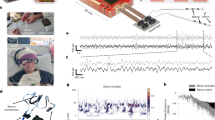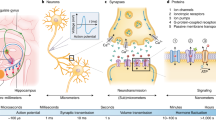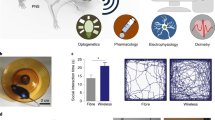Abstract
Closed-loop neuromodulation systems aim to treat a variety of neurological conditions by delivering and adjusting therapeutic electrical stimulation in response to a patient’s neural state, recorded in real time. Existing systems are limited by low channel counts, lack of algorithmic flexibility, and the distortion of recorded signals by large and persistent stimulation artefacts. Here, we describe an artefact-free wireless neuromodulation device that enables research applications requiring high-throughput data streaming, low-latency biosignal processing, and simultaneous sensing and stimulation. The device is a miniaturized neural interface capable of closed-loop recording and stimulation on 128 channels, with on-board processing to fully cancel stimulation artefacts. In addition, it can detect neural biomarkers and automatically adjust stimulation parameters in closed-loop mode. In a behaving non-human primate, the device enabled long-term recordings of local field potentials and the real-time cancellation of stimulation artefacts, as well as closed-loop stimulation to disrupt movement preparatory activity during a delayed-reach task. The neuromodulation device may help advance neuroscientific discovery and preclinical investigations of stimulation-based therapeutic interventions.
This is a preview of subscription content, access via your institution
Access options
Access Nature and 54 other Nature Portfolio journals
Get Nature+, our best-value online-access subscription
$29.99 / 30 days
cancel any time
Subscribe to this journal
Receive 12 digital issues and online access to articles
$99.00 per year
only $8.25 per issue
Buy this article
- Purchase on Springer Link
- Instant access to full article PDF
Prices may be subject to local taxes which are calculated during checkout






Similar content being viewed by others
Data availability
The data that support the findings of this study are available from the corresponding author upon reasonable request.
References
Eisenstein, M. Electrotherapy: shock value. Nature 538, S10–S12 (2016).
Sun, F. T. & Morrell, M. J. Closed-loop neurostimulation: the clinical experience. Neurotherapeutics 11, 553–563 (2014).
Sun, F. T., Morrell, M. J. & Wharen, R. E. Responsive cortical stimulation for the treatment of epilepsy. Neurotherapeutics 5, 68–74 (2008).
Rosin, B. et al. Closed-loop deep brain stimulation is superior in ameliorating parkinsonism. Neuron 72, 370–384 (2011).
Little, S. et al. Adaptive deep brain stimulation in advanced Parkinson disease. Ann. Neurol. 74, 449–457 (2013).
Morrell, M. J. Responsive cortical stimulation for the treatment of medically intractable partial epilepsy. Neurology 77, 1295–1304 (2011).
Beuter, A., Lefaucheur, J.-P. & Modolo, J. Closed-loop cortical neuromodulation in Parkinson’s disease: an alternative to deep brain stimulation? Clin. Neurophysiol. 125, 874–885 (2014).
Swann, N. C. et al. Gamma oscillations in the hyperkinetic state detected with chronic human brain recordings in Parkinson’s disease. J. Neurosci. 36, 6445–6458 (2016).
Little, S. et al. Bilateral adaptive deep brain stimulation is effective in Parkinson’s disease. J. Neurol. Neurosurg. Psychiatry 87, 717–721 (2016).
Malekmohammadi, M. et al. Kinematic adaptive deep brain stimulation for resting tremor in Parkinson’s disease. Mov. Disord. 31, 426–428 (2016).
Rosa, M. et al. Adaptive deep brain stimulation in a freely moving parkinsonian patient. Mov. Disord. 30, 1003–1005 (2015).
Yin, M. et al. Wireless neurosensor for full-spectrum electrophysiology recordings during free behavior. Neuron 84, 1170–1182 (2014).
Gao, H. et al. HermesE: a 96-channel full data rate direct neural interface in 0.13 μm CMOS. IEEE J. Solid-State Circuits 47, 1043–1055 (2012).
Stanslaski, S. et al. Design and validation of a fully implantable, chronic, closed-loop neuromodulation device with concurrent sensing and stimulation. IEEE. Trans. Neural Syst. Rehabil. Eng. 20, 410–421 (2012).
Zanos, S., Richardson, A. G., Shupe, L., Miles, F. P. & Fetz, E. E. The neurochip-2: an autonomous head-fixed computer for recording and stimulating in freely behaving monkeys. IEEE. Trans. Neural Syst. Rehabil. Eng. 19, 427–435 (2011).
Liu, X. et al. The PennBMBI: a general purpose wireless brain–machine–brain interface system for unrestrained animals. In 2014 IEEE International Symposium on Circuits and Systems 650–653 (IEEE, 2014).
RNS System User Manual (NeuroPace, 2015).
Bagheri, A. et al. Massively-parallel neuromonitoring and neurostimulation rodent headset with nanotextured flexible microelectrodes. IEEE Trans. Biomed. Circuits Syst. 7, 601–609 (2013).
Kassiri, H. et al. Closed-loop neurostimulators: a survey and a seizure-predicting design example for intractable epilepsy treatment. IEEE Trans. Biomed. Circuits Syst. 11, 1026–1040 (2017).
Abdelhalim, K., Jafari, H. M., Kokarovtseva, L., Velazquez, J. L. P. & Genov, R. 64-Channel UWB wireless neural vector analyzer SOC with a closed-loop phase synchrony-triggered neurostimulator. IEEE J. Solid-State Circuits 48, 2494–2510 (2013).
Kassiri, H. et al. Rail-to-rail-input dual-radio 64-channel closed-loop neurostimulator. IEEE J. Solid-State Circuits 52, 2793–2810 (2017).
Cheng, C.-H. et al. A fully integrated closed-loop neuromodulation SoC with wireless power and bi-directional data telemetry for real-time human epileptic seizure control. In Symposium on VLSI Circuits C44–C45 (IEEE, 2017).
Kassiri, H. et al. Battery-less tri-band-radio neuro-monitor and responsive neurostimulator for diagnostics and treatment of neurological disorders. IEEE J. Solid-State Circuits 51, 1274–1289 (2016).
Rhew, H. G. et al. A fully self-contained logarithmic closed-loop deep brain stimulation SoC with wireless telemetry and wireless power management. IEEE J. Solid-State Circuits 49, 2213–2227 (2014).
Chen, W. M. et al. A fully integrated 8-channel closed-loop neural-prosthetic CMOS SoC for real-time epileptic seizure control. IEEE J. Solid-State Circuits 49, 232–247 (2014).
Johnson, B. C. et al. An implantable 700 µW 64-channel neuromodulation IC for simultaneous recording and stimulation with rapid artifact recovery. In Symposium on VLSI Circuits C48–C49 (IEEE, 2017).
Kuhn, A. A. et al. High-frequency stimulation of the subthalamic nucleus suppresses oscillatory activity in patients with Parkinson’s disease in parallel with improvement in motor performance. J. Neurosci. 28, 6165–6173 (2008).
Yoshida, F. et al. Value of subthalamic nucleus local field potentials recordings in predicting stimulation parameters for deep brain stimulation in Parkinson’s disease. J. Neurol. Neurosurg. Psychiatry 81, 885–889 (2010).
Weinberger, M. et al. Beta oscillatory activity in the subthalamic nucleus and its relation to dopaminergic response in Parkinson’s disease. J. Neurophysiol. 96, 3248–3256 (2006).
Halpern, C. H., Samadani, U., Litt, B., Jaggi, J. L. & Baltuch, G. H. Deep brain stimulation for epilepsy. Neurotherapeutics 5, 59–67 (2008).
So, K., Dangi, S., Orsborn, A. L., Gastpar, M. C. & Carmena, J. M. Subject-specific modulation of local field potential spectral power during brain–machine interface control in primates. J. Neural Eng. 11, 26002 (2014).
Flint, R. D., Lindberg, E. W., Jordan, L. R., Miller, L. E. & Slutzky, M. W. Accurate decoding of reaching movements from field potentials in the absence of spikes. J. Neural Eng. 9, 46006 (2012).
Flint, R. D., Ethier, C., Oby, E. R., Miller, L. E. & Slutzky, M. W. Local field potentials allow accurate decoding of muscle activity. J. Neurophysiol. 108, 18–24 (2012).
Khanna, P. & Carmena, J. M. Beta band oscillations in motor cortex reflect neural population signals that delay movement onset. eLife 6, 1–31 (2017).
Stavisky, S. D., Kao, J. C., Nuyujukian, P., Ryu, S. I. & Shenoy, K. V. A high performing brain–machine interface driven by low-frequency local field potentials alone and together with spikes. J. Neural Eng. 12, 36009 (2015).
Rubino, D., Robbins, K. A. & Hatsopoulos, N. G. Propagating waves mediate information transfer in the motor cortex. Nat. Neurosci. 9, 1549–1557 (2006).
Sanes, J. N. & Donoghue, J. P. Oscillations in local field potentials of the primate motor cortex during voluntary movement. Proc. Natl Acad. Sci. USA 90, 4470–4474 (1993).
Mehring, C. et al. Inference of hand movements from local field potentials in monkey motor cortex. Nat. Neurosci. 6, 1253–1254 (2003).
Leventhal, D. K. et al. Basal ganglia beta oscillations accompany cue utilization. Neuron 73, 523–536 (2012).
Lundqvist, M. et al. Gamma and beta bursts underlie working memory. Neuron 90, 152–164 (2016).
Pesaran, B. et al. Temporal structure in neuronal activity during working memory in macaque parietal cortex. Nat. Neurosci. 5, 805–811 (2002).
Harrison, R. R. et al. A low-power integrated circuit for a wireless 100-electrode neural recording system. IEEE J. Solid-State Circuits 42, 123–133 (2007).
Zhang, Fan, Holleman, J. & Otis, B. P. Design of ultra-low power biopotential amplifiers for biosignal acquisition applications. IEEE Trans. Biomed. Circuits Syst. 6, 344–355 (2012).
Shulyzki, R. et al. 320-Channel active probe for high-resolution neuromonitoring and responsive neurostimulation. IEEE Trans. Biomed. Circuits Syst. 9, 34–49 (2015).
Liu, X., Zhang, M., Richardson, A. G., Lucas, T. H. & Van der Spiegel, J. Design of a closed-loop, bidirectional brain machine interface system with energy efficient neural feature extraction and PID control. IEEE Trans. Biomed. Circuits Syst. 11, 729–742 (2017).
Jiang, W., Hokhikyan, V., Chandrakumar, H., Karkare, V. & Marković, D. A ±50-mV linear-input-range VCO-based neural-recording front-end with digital nonlinearity correction. IEEE J. Solid-State Circuits 52, 173–184 (2017).
Mendrela, A. E. et al. A bidirectional neural interface circuit with active stimulation artifact cancellation and cross-channel common-mode noise suppression. IEEE J. Solid-State Circuits 51, 955–965 (2016).
Culaclii, S., Kim, B., Lo, Y.-K. & Liu, W. A hybrid hardware and software approach for cancelling stimulus artifacts during same-electrode neural stimulation and recording. In 38th Annual International Conference of the IEEE Engineering in Medicine and Biology Society 6190–6193 (IEEE, 2016).
Heer, F. et al. Single-chip microelectronic system to interface with living cells. Biosens. Bioelectron. 22, 2546–2553 (2007).
Viswam, V. et al. 2048 action potential recording channels with 2.4 μVrms noise and stimulation artifact suppression. In IEEE Biomedical Circuits and Systems Conference 136–139 (IEEE, 2016).
Limnuson, K., Lu, H., Chiel, H. J. & Mohseni, P. Real-time stimulus artifact rejection via template subtraction. IEEE Trans. Biomed. Circuits Syst. 8, 391–400 (2014).
Wichmann, T. & Devergnas, A. A novel device to suppress electrical stimulus artifacts in electrophysiological experiments. J. Neurosci. Methods 201, 1–8 (2011).
Heffer, L. F. & Fallon, J. B. A novel stimulus artifact removal technique for high-rate electrical stimulation. J. Neurosci. Methods 170, 277–284 (2008).
Hoffmann, U., Cho, W., Ramos-Murguialday, A. & Keller, T. Detection and removal of stimulation artifacts in electroencephalogram recordings. In Proc. Annual International Conference of the IEEE Engineering in Medicine and Biology Society 7159–7162 (IEEE, 2011).
Waddell, C., Pratt, J. A., Porr, B. & Ewing, S. Deep brain stimulation artifact removal through under-sampling and cubic-spline interpolation. In 2nd International Congress on Image and Signal Processing 1–5 (IEEE, 2009).
Dadarlat, M. C., O’Doherty, J. E. & Sabes, P. N. A learning-based approach to artificial sensory feedback leads to optimal integration. Nat. Neurosci. 18, 138–144 (2014).
Pais-Vieira, M., Lebedev, M., Kunicki, C., Wang, J. & Nicolelis, M. A. L. A brain-to-brain interface for real-time sharing of sensorimotor information. Sci. Rep. 3, 1–10 (2013).
Fitzsimmons, N. A., Drake, W., Hanson, T. L., Lebedev, M. A. & Nicolelis, M. A. L. Primate reaching cued by multichannel spatiotemporal cortical microstimulation. J. Neurosci. 27, 5593–5602 (2007).
O’Doherty, J. E. et al. Active tactile exploration using a brain–machine–brain interface. Nature 479, 228–231 (2011).
O’Doherty, J. E., Lebedev, M. A., Li, Z. & Nicolelis, M. A. L. Virtual active touch using randomly patterned intracortical microstimulation. IEEE. Trans. Neural Syst. Rehabil. Eng. 20, 85–93 (2012).
Zaaimi, B., Ruiz-Torres, R., Solla, S. A. & Miller, L. E. Multi-electrode stimulation in somatosensory cortex increases probability of detection. J. Neural Eng. 10, 56013 (2013).
Moin, A. et al. Powering and communication for OMNI: a distributed and modular closed-loop neuromodulation device. In 38th Annual International Conference of the IEEE Engineering in Medicine and Biology Society 4471–4474 (IEEE, 2016).
Canolty, R. T., Ganguly, K. & Carmena, J. M. Task-dependent changes in cross-level coupling between single neurons and oscillatory activity in multiscale networks. PLoS Comput. Biol. 8, e1002809 (2012).
Saleh, M., Reimer, J., Penn, R., Ojakangas, C. L. & Hatsopoulos, N. G. Clinical study fast and slow oscillations in human primary motor cortex predict oncoming behaviorally relevant cues. Neuron 65, 461–471 (2010).
Bastian, A., Schoner, G. & Riehle, A. Preshaping and continuous evolution of motor cortical representations during movement preparation. Eur. J. Neurosci. 18, 2047–2058 (2003).
Churchland, M. M., Yu, B. M., Ryu, S. I., Santhanam, G. & Shenoy, K. V. Neural variability in premotor cortex provides a signature of motor preparation. J. Neurosci. 26, 3697–3712 (2006).
Churchland, M. M. & Shenoy, K. V. Delay of movement caused by disruption of cortical preparatory activity. J. Neurophysiol. 97, 348–359 (2007).
Donoghue, J. P., Sanes, J. N., Hatsopoulos, N. G. & Gaal, G. Neural discharge and local field potential oscillations in primate motor cortex during voluntary movements. J. Neurophysiol. 79, 159–173 (1998).
Cantero, J. L., Atienza, M. & Salas, R. M. Human alpha oscillations in wakefulness, drowsiness period, and REM sleep: different electroencephalographic phenomena within the alpha band. Neurphysiol. Clin. 32, 54–71 (2002).
Schulz, H. Rethinking sleep analysis. J. Clin. Sleep Med. 4, 99–103 (2008).
Rouse, A. G. et al. A chronic generalized bi-directional brain–machine interface. J. Neural Eng. 8, 36018 (2011).
Avestruz, A.-T. et al. A 5 µW/channel spectral analysis IC for chronic bidirectional brain–machine interfaces. IEEE J. Solid-State Circuits 43, 3006–3024 (2008).
Salam, M. T., Perez Velazquez, J. L. & Genov, R. Seizure suppression efficacy of closed-loop versus open-loop deep brain stimulation in a rodent model of epilepsy. IEEE. Trans. Neural Syst. Rehabil. Eng. 24, 710–719 (2016).
Public-Private Partnership Program: devices and support specific manufacturers. NIH BRAIN Initiative https://www.braininitiative.nih.gov/resources/public-private-partnership-program-devices-support-specific-manufacturers (2018).
Thomas, G. P. & Jobst, B. C. Critical review of the responsive neurostimulator system for epilepsy. Med. Devices 8, 405–411 (2015).
Lempka, S. F., Howell, B., Gunalan, K., Machado, A. G. & McIntyre, C. C. Characterization of the stimulus waveforms generated by implantable pulse generators for deep brain stimulation. Clin. Neurophysiol. 129, 731–742 (2018).
Acknowledgements
This work was supported in part by the Defense Advanced Research Projects Agency (W911NF-14–2–0043 to R.M., J.M.R. and J.M.C.) and National Science Foundation Graduate Research Fellowship Program (grant number 1106400 to A.Z.). The authors thank the Wagner Foundation and the sponsors of the Berkeley Wireless Research Center. They also thank E. Alon, S. Gambini and I. Izyumin for technical discussion.
Author information
Authors and Affiliations
Contributions
J.M.R., J.M.C and R.M. are co-principal investigators. A.Z., B.C.J., G.A., A.M., F.L.B., J.M.R. and R.M. designed and tested the system. B.C.J. and R.M. designed and tested the integrated circuits. S.R.S. and J.M.C. designed the in vivo experiments. A.Z., S.R.S., B.C.J., G.A. and A.M. performed the experiments and analysis. J.M.R., J.M.C. and R.M. oversaw the project. A.Z., S.R.S., B.C.J., G.A., A.M., J.M.R., J.M.C. and R.M. wrote and edited the paper.
Corresponding author
Ethics declarations
Competing interests
B.C.J., J.M.R., J.M.C. and R.M. have financial interests in Cortera Neurotechnologies, which has filed a patent application on the integrated circuit used in this work.
Additional information
Publisher’s note: Springer Nature remains neutral with regard to jurisdictional claims in published maps and institutional affiliations.
Supplementary information
Supplementary Information
Supplementary discussion, figures and tables
Rights and permissions
About this article
Cite this article
Zhou, A., Santacruz, S.R., Johnson, B.C. et al. A wireless and artefact-free 128-channel neuromodulation device for closed-loop stimulation and recording in non-human primates. Nat Biomed Eng 3, 15–26 (2019). https://doi.org/10.1038/s41551-018-0323-x
Received:
Accepted:
Published:
Issue Date:
DOI: https://doi.org/10.1038/s41551-018-0323-x
This article is cited by
-
Machine learning-based high-frequency neuronal spike reconstruction from low-frequency and low-sampling-rate recordings
Nature Communications (2024)
-
In vivo closed-loop control of a locust’s leg using nerve stimulation
Scientific Reports (2022)
-
Neuron devices: emerging prospects in neural interfaces and recognition
Microsystems & Nanoengineering (2022)
-
Recent advances in wireless epicortical and intracortical neuronal recording systems
Science China Information Sciences (2022)
-
High-density neural recording system design
Biomedical Engineering Letters (2022)



